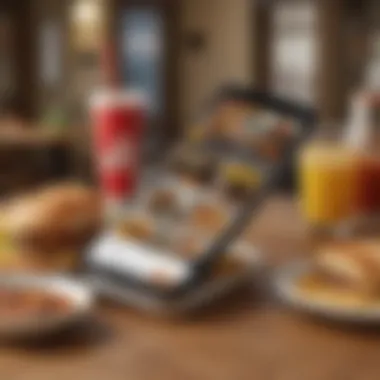Find Open Delivery Restaurants Near You Today


Intro
Finding delivery restaurants that are open today can be a challenging task. Often, we might crave a particular dish only to discover that the restaurant we had in mind is closed or unreachable. In today’s fast-paced world, having the ability to quickly locate available food options is essential. This guide aims to provide you with various tips and techniques to navigate the world of food delivery effectively.
The need for food delivery options has surged, particularly due to the changes in dining habits and the effects of recent events on how we eat. Understanding which restaurants are accessible, and how to find them, can significantly enhance your dining experience. In this piece, we'll cover the most reliable methods for locating open delivery restaurants, offer insights into popular cuisines, and discuss how to utilize online platforms effectively.
This exploration is not just about satisfying hunger; it’s about providing a rich dining experience right from your home.
The Importance of Knowing What’s Open
When contemplating ordering in, knowing which restaurants are available is crucial. It saves time and avoids disappointment. As you consider your options, be aware that many places might alter their hours depending on various factors like location, day of the week, or holidays.
Who wants to decide on the perfect meal only to find out the establishment is closed? The following sections will delve into how to address these issues and provide a streamlined approach for your next meal.
Methods to Find Open Restaurants
There are several effective methods you can use to check which delivery restaurants are open near you:
- Use Delivery Apps: Platforms like Uber Eats, DoorDash, and Grubhub are designed to show available options based on your location.
- Search Engines: A quick search on Google might reveal local restaurants and their hours. Typing phrases like "restaurants open near me" can yield fruitful results.
- Social Media: Many restaurants update their hours on platforms like Facebook and Instagram. This can be an excellent resource for current information.
- Ask for Recommendations: Engaging with friends or local forums such as on Reddit can provide personal recommendations and insights into what is currently trending in your area.
Using Online Platforms Effectively
To make the most out of your online search, consider:
- Filtering by cuisine types you enjoy.
- Reading customer reviews for insights into food quality and service.
- Checking for special deals or promotions that some restaurants might offer through specific platforms.
By doing so, you ensure that the meal you choose is not only available but also desirable.
Ending
Understanding the nuances behind locating open delivery restaurants allows you not just to order food, but to experience various culinary offerings. Navigate through delivery platforms, stay updated via social media, and connect with your community for the best results. With a solid strategy in place, satisfying your craving can become a seamless part of your day.
Understanding the Modern Delivery Restaurant Landscape
Understanding the modern delivery restaurant landscape is vital for anyone interested in accessing a variety of food options available at their convenience. The rise of food delivery services has reshaped how people approach dining. It caters to different lifestyles and preferences, especially in today’s fast-paced world. This section will discuss the historical context, current trends, and technological advancements that have influenced this industry.
Evolution of Food Delivery Services
Food delivery services have come a long way. Traditionally, takeout was the norm, where customers would call to place orders or visit restaurants directly. The past two decades have seen a revolution in how food arrives at people’s doors. The introduction of online platforms like Uber Eats, DoorDash, and Grubhub marked a significant shift. Consumers can browse through an extensive selection of restaurants and cuisines with a few taps on their smartphones.
Furthermore, the COVID-19 pandemic accelerated this evolution. Many restaurants, forced to close their dining rooms, pivoted quickly to delivery and takeout options. This transition led to a surge in new businesses focusing solely on delivery or adding it to their service repertoire. The options for customers grew, which increased the demand for delivery services. Ultimately, this evolution has changed consumer expectations and behavior regarding food service.
Market Trends and Growth
The food delivery market has seen remarkable growth. According to recent studies, the global online food delivery market is expected to reach billions of dollars in the next few years. Factors contributing to this growth include increased demand for convenience and a shift in consumer dining habits. People are now looking for flexible dining options that fit their busy lifestyles.
Key trends shaping the market include:
- Rise of ghost kitchens: These are kitchens without a dining space, often set up in industrial areas to reduce overhead costs.
- Health and wellness options: More restaurants are offering healthy menu choices to cater to health-conscious consumers.
- Subscription services: Some platforms provide memberships that offer lower delivery fees or exclusive offers to loyal customers.
These trends indicate that the market is dynamic. Restaurants that recognize and adapt to these trends can thrive in a highly competitive environment.
Impact of Technology on Restaurant Deliveries
Technology plays a crucial role in the efficiency of restaurant deliveries. Innovations like GPS tracking allow customers to follow their orders in real-time. This has enhanced transparency and trust between food providers and consumers. Additionally, data analytics helps restaurants understand customer preferences and optimize menus accordingly.
Digital payment systems have also streamlined the ordering process. Today, consumers can pay with a simple click, making transactions faster and more convenient. Another important element is the rise of mobile apps. These applications make finding local restaurants and placing orders easier than ever before. As technology continues to develop, its impact on food delivery will likely increase, prompting more efficient and customer-friendly services.
Finding Delivery Restaurants Open Today
In an age where convenience shapes dining habits, locating delivery restaurants that are open today holds significant value for consumers. The ability to quickly find available restaurants can enhance the overall dining experience and help manage hunger effectively. Whether it’s a late-night craving or an impromptu lunch, understanding how to identify open establishments can save time and reduce frustration.


The process of finding open delivery options involves several factors. First, knowing what eateries are nearby is essential. In addition, the operating hours of these restaurants can vary greatly, often leading to confusion for diners. This is particularly relevant during holidays or special events when many places may alter their schedules.
Moreover, the variety of cuisines available can play a crucial role in a person’s choice. Different times of the day might call for different types of meals, whether one prefers a hearty breakfast, a light lunch, or a substantial dinner. Therefore, having a clear method for identifying what's open allows consumers to explore various food options effectively.
Furthermore, understanding how to utilize available tools can improve this search process. With numerous online platforms and mobile apps dedicated to food delivery, consumers can access a broad range of cuisines and restaurants with just a few clicks. This streamlining of access goes a long way in ensuring an enjoyable experience.
Ultimately, being informed about how to find delivery restaurants that are open today empowers diners to make better choices while catering to their immediate cravings.
Utilizing Online Search Tools
Online search tools have become indispensable for many seeking to find food delivery options. With internet access becoming increasingly prevalent, consumers can leverage resources to identify local restaurants open for takeout or delivery.
Websites dedicated to food delivery often allow users to filter options based on the time of day. Tools provided by platforms like Grubhub and DoorDash enable better search capabilities. They allow you to enter a location and immediately see which restaurants are currently delivering.
The key advantages of using these online search tools include:
- Immediate access to menus.
- Ability to read customer reviews.
- Filtering options based on cuisine or dietary needs.
To optimize the search further, potential customers can also check specific restaurant websites for updated delivery hours and special menus that might not be listed on third-party services.
Mobile Applications for Easier Access
The rise of mobile applications brings food delivery to the palm of your hand. Applications like Uber Eats and Postmates enhance the search process for delivery restaurants in significant ways.
These apps not only provide alerts for restaurants that are currently open but also streamline the ordering process. Users can browse through various eateries, check real-time availability, and read reviews. This adds another layer of comfort and efficiency to dining decisions.
Key features of mobile apps include:
- User-friendly interfaces.
- Real-time status updates on orders.
- Location tracking to find nearby restaurants easily.
In essence, mobile applications represent a modern tool that simplifies the experience of finding open delivery restaurants, allowing users to manage their meals more effectively.
Social Media and Community Recommendations
Social media platforms provide unique insights into food delivery options that might not be visible through traditional methods. Many people turn to platforms like Facebook, Instagram, and Reddit to discover local dining spots and get recommendations from their community.
Social media allows users to engage with other food enthusiasts, share experiences, and find out which restaurants are currently offering delivery.
Benefits of utilizing social media for this purpose include:
- Access to real-time dining suggestions.
- Interaction with restaurant owners and staff.
- Ability to see visual content of dishes from other customers.
In summary, tapping into the collective knowledge of communities on social networks can significantly aid in finding delivery restaurants that are open today. This collaborative approach not only broadens options but can also lead to discovering hidden gems in local dining scenes.
Social media platforms serve as modern-day forums where diners can exchange valuable insights into local restaurant operations.
Popular Types of Cuisine Available for Delivery
The current landscape of food delivery highlights a broad array of cuisine options that can cater to any palate. Understanding the popular types of cuisine available for delivery is essential for maximizing your dining experience. It offers not only variety but also convenience. This section will explore several cuisine types that are particularly favored and the considerations that come with each.
Exploring Asian Cuisine Options
Asian cuisine stands out for its unique flavors and diverse dishes. From sushi to noodles, the variety is profound. Japanese, Chinese, Thai, and Indian dishes have become staples in many delivery services. This popularity can be attributed to the authenticity and freshness that many local restaurants bring to their meals.
When considering Asian cuisine for delivery, it's essential to note a few key features:
- Diversity of Dishes: Options range from spicy curries to savory dumplings, catering to different taste preferences.
- Quality and Freshness: Many Asian dishes maintain their quality even after transport, allowing for greater customer satisfaction.
- Dietary Considerations: Many Asian cuisines offer vegan or gluten-free options, making it easier for those with dietary restrictions.
The Rise of Plant-Based Delivery Choices
As awareness of health and environmental issues grows, the demand for plant-based cuisine continues to rise. More restaurants are including vegan and vegetarian options in their delivery menus. This trend reflects not only a commitment to sustainability but also a need for inclusivity in dining.


Consider the following benefits of plant-based delivery:
- Health Benefits: Plant-based meals are often lower in calories and rich in nutrients. They appeal to health-conscious consumers.
- Variety: Despite common perceptions, plant-based food can be incredibly diverse. From hearty lentil dishes to innovative faux-meats, the options are expanding.
- Accessibility: Many delivery platforms now provide filters to specifically search for vegan or vegetarian choices, making it easier to find suitable meals.
Traditional Comfort Foods and Their Availability
Comfort food remains a favorite among many consumers. Classics like pizza, burgers, and pasta are always in demand. The availability of traditional comfort foods through delivery options can evoke feelings of nostalgia and satisfaction.
Key aspects to consider include:
- Familiar Flavors: These dishes often remind individuals of home-cooked meals, making them a popular choice.
- Flexibility: Most restaurants offer customization options, allowing for personal preferences in toppings or ingredients.
- Satisfaction: Comfort foods are typically hearty and fulfilling, offering a satisfying dining experience, especially after a long day.
"The accessibility of various cuisines through delivery services makes it easier to explore new flavors without leaving home."
In sum, embracing the various cuisines available for delivery can enhance your dining experience significantly. Each type of cuisine offers unique qualities and possibilities, making the search for delivery options an exciting culinary journey.
Optimizing Your Delivery Experience
Optimizing your delivery experience is crucial for ensuring that your food arrives as expected and satisfies your cravings. With various options available, implementing strategies can enhance your overall satisfaction with food delivery services. This section will explore key elements that contribute to a better experience such as identifying dietary needs, comparing delivery platforms, and ensuring food quality upon arrival.
Identifying Your Dietary Needs
Understanding your dietary needs is the first step in optimizing your delivery experience. Each person's requirements differ based on health goals, allergies, or preferences. Being aware of these aspects can lead to a more enjoyable meal.
When selecting food, consider the following:
- Allergies: Always check restaurant menus for allergens. Many places provide allergen information online.
- Dietary Restrictions: Whether you are gluten-free, vegan, or following a keto diet, knowing which restaurants cater to your needs is essential.
- Nutritional Goals: If you focus on maintaining a certain caloric intake or prefer low-fat meals, that influences your choices dramatically.
Utilizing apps that offer filters for specific dietary needs can save time and help avoid unwanted surprises with your order.
Comparing Delivery Platforms for Best Options
In today’s market, many delivery platforms exist, each offering different services and selections. Choosing the right one can heavily impact your dining experience. Here are factors to consider:
- Fees and Pricing: Each platform may have different delivery charges and service fees. Assessing these can affect your overall budget.
- Restaurant Variety: Some platforms have more restaurant partners than others. Ensure your desired cuisines are adequately represented.
- Delivery Times: Check estimated delivery times to judge the reliability of the service.
- User Experience: An intuitive interface can simplify the ordering process significantly.
Researching reviews on Reddit or checking customer feedback can provide real insight into the best options available. It is vital to select the platform that aligns best with your preferences.
Tips for Ensuring Food Quality upon Arrival
Receiving a meal in perfect condition is a priority for many food lovers. Here are some practical tips to help maintain food quality from the restaurant to your door:
- Order Tracking: Use platforms that provide real-time tracking. This feature allows you to know when to expect your meal.
- Timing Your Order: Ordering at peak times may result in longer wait times. Try to order during off-peak hours for faster service.
- Packaging Considerations: Look for restaurants known for reliable packaging. Well-sealed containers maintain freshness and temperature better.
- Assessing Delivery Conditions: Pay attention to weather conditions, as they can affect delivery. If it’s raining, for example, delivery might take longer, and food could arrive soggy.
Effective food delivery requires attention and awareness. A well-planned order can turn a simple meal into a delightful experience.
By following these guidelines, your encounters with delivery restaurants can be more enjoyable and efficient. Properly assessing your dietary needs, comparing various platforms, and ensuring food quality are all integral in securing a satisfactory dining experience.
Understanding Delivery Fees and Costs
Understanding delivery fees and costs is crucial in navigating the landscape of modern food delivery services. As more consumers turn to restaurants for convenient meal options, grasping these financial aspects enables better decision-making. Delivery charges may differ significantly based on various factors like distance, type of service, and restaurant policies. Moreover, hidden costs can catch consumers off guard. This section aims to clarify these important elements, helping food lovers to approach delivery thoughtfully and within their budgets.
Breakdown of Delivery Charges
Delivery charges encompass various components that contribute to the total amount due when ordering from a restaurant. The most apparent is the base delivery fee, a charge typically calculated based on distance or a flat rate set by the restaurant or delivery service.
In addition to this base fee, several other factors may influence overall costs:
- Restaurant Markup: Many delivery platforms charge restaurants fees for using their services, which can lead to higher menu prices for consumers.
- Service Fees: Delivery apps often impose additional fees to cover operational costs, further inflating total prices.
- Tip for Delivery Driver: While optional, tipping is customary and should be factored into budgeting for your meals.
Understanding each of these components helps consumers anticipate costs before placing an order and makes for a more informed dining choice.


Hidden Costs in Food Delivery
Hidden costs in food delivery can unexpectedly increase a consumer's bill. Often, these fees are not immediately visible at the start of the ordering process, leading to potential frustration at checkout. Here are some common hidden costs to be aware of:
- Packaging Fees: Certain restaurants may charge extra for the packaging used to transport food safely.
- Surge Pricing: During peak hours or instances of high demand, fees may rise due to surge pricing models utilized by many delivery services.
- Minimum Order Requirements: Some platforms or restaurants enforce minimum order limits to qualify for delivery, which may encourage purchasing more food than needed.
Awareness of these hidden costs allows consumers to be proactive, avoiding unpleasant surprises at payment.
Managing Budgets for Regular Delivery
For individuals who frequently order deliveries, managing the budget effectively is essential. This approach ensures that convenience does not lead to overspending. Here are several tips to keep expenses in check:
- Create a Monthly Food Budget: Define a clear spending limit for food deliveries each month and stick to it. This aids in balancing convenience with financial responsibility.
- Plan Meals Ahead: Allocate specific days for delivery rather than spontaneous ordering. This helps in both budgeting and nutrition.
- Take Advantage of Promotions: Many delivery services offer discounts or promotions. Sign up for newsletters or notifications to stay updated.
- Track Expenses: Maintain a record of delivery spending to identify trends or areas to reduce costs.
By employing these strategies, consumers can enjoy the convenience of food delivery without breaking the bank.
Customer Perspectives on Delivery Restaurants
Understanding customer perspectives is essential in the context of delivery restaurants. It goes beyond merely evaluating the food; it entails comprehending the complete experience. This perspective paints a clearer picture of not just what customers want but why they make specific choices.
Today, dining preferences reflect broader trends influenced by convenience, health, and ethical considerations. Customers often seek meals that suit their individual palettes, nutritional desires, and lifestyles. Delivery services have introduced a new dynamic, allowing people to enjoy their favorite cuisines without stepping out. It is crucial to note that customer experiences with delivery can significantly affect restaurant reputations and success.
Evaluating Service Quality
Service quality in delivery restaurants plays a pivotal role. It encompasses aspects like order accuracy, timeliness, and customer service. Each interaction contributes to the overall impression that customers hold about a restaurant. A well-executed order arriving on time can enhance satisfaction, while discrepancies or delays can lead to disappointment.
Restaurants need to invest in understanding their service metrics. Customer reviews often provide valuable insights into their service quality. If a restaurant consistently receives poor ratings, this signals a need for improvement. For example, accuracy in fulfilling dietary restrictions or special requests can heavily influence order satisfaction. Effective communication is key to addressing potential issues before they affect the dining experience.
Feedback Mechanisms and Their Importance
Feedback mechanisms are vital for understanding customer perceptions. Many restaurants use platforms such as Yelp or Google Reviews to gather customer insights. This feedback not only aids restaurants in enhancing their offerings but also helps consumers make informed choices.
"Customer feedback serves as a compass for delivering improved experiences, shaping both menu items and service practices."
Moreover, actively engaging with feedback demonstrates that businesses value their patrons’ opinions. Positive interactions can foster customer loyalty, while addressing negative reviews can mitigate damage. In today's competitive landscape, restaurants need to take feedback seriously to thrive.
Case Studies of Successful Restaurants
Examining the success stories of specific restaurants can provide powerful lessons about customer perspectives. For instance, Domino’s Pizza has consistently evolved based on consumer feedback, streamlining their ordering process and introducing technology like pizza trackers.
Another example is Chipotle. They have adapted their menu to align with customer interest in sustainability and health-conscious options. By listening to feedback and adjusting business practices, these restaurants build a loyal customer base.
Ultimately, a strong understanding of customer perspectives enables restaurants to navigate the competitive delivery landscape effectively, ensuring that they remain relevant and appealing in a dynamic market.
The Future of Delivery Restaurants
The future of delivery restaurants holds significant implications for both consumers and the industry itself. As lifestyles continuously shift towards convenience, understanding emerging trends will help consumers make informed choices about their dining experiences. With technology at the forefront, the upcoming years promise to reshape how food reaches our tables. Sustainability, innovation, and consumer preferences will play crucial roles in this evolution.
Sustainability in Food Delivery Practices
Sustainability is becoming increasingly relevant in food delivery. As awareness of environmental issues grows, customers gravitate toward restaurants that prioritize eco-friendly practices. Delivery restaurants will likely adopt smarter packaging solutions, opting for recyclable or biodegradable materials to reduce waste. Companies such as Uber Eats and DoorDash are already exploring ways to limit their carbon footprints through partnerships with sustainable restaurants.
Moreover, many delivery services will work with businesses to optimize their delivery routes. Such measures not only enhance efficiency but also diminish emissions associated with transport. Customers who seek out sustainable options may decide to favor these restaurants, reshaping the competitive landscape.
Innovations in Delivery Methods
As technology evolves, so will the methods of food delivery. Current innovations include contactless delivery, automated services, and drone technology. These advancements aim to enhance both safety and efficiency in food transport. For instance, some restaurants are trialing AI-driven robots to deliver food within local neighborhoods. This method can reduce reliance on delivery drivers, possibly minimizing wait times for consumers.
Another noteworthy area is the use of advanced GPS tracking. Consumers increasingly expect real-time updates about their orders. Innovations in this field can contribute to managing customer expectations and improving satisfaction rates. Furthermore, integrating augmented reality (AR) into delivery apps may soon allow customers to visualize their meals before ordering, thereby enhancing their overall experience.
Projecting Consumer Trends and Preferences
Consumer behavior is in constant flux, influenced by societal changes and technological advancements. As convenience continues to define dining choices, preferences are moving towards healthy and diverse options. The rise of plant-based diets and interest in global cuisines are likely to influence delivery menus. Consumers may favor restaurants that offer a wide variety of dietary choices, ensuring all needs are met.
Moreover, local sourcing of ingredients will potentially gain traction. Dining trends increasingly focus on quality and transparency in sourcing practices. Transparency fosters trust, compelling many consumers to prefer restaurants that share their supplier stories.
In summary, the future of delivery restaurants will likely hinge on sustainability, technological advancements, and evolving consumer preferences. As the industry adapts, both customers and restaurants will benefit from enhanced experiences that align with contemporary values and expectations.







